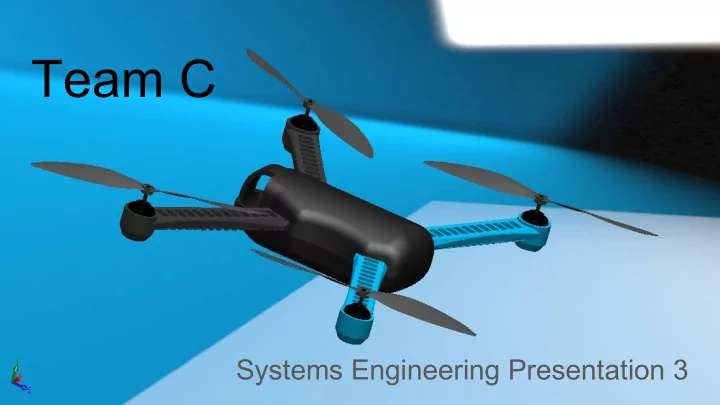

Team C Systems Engineering Presentation 3
WBS reflecting good progress towards FVE On track for FVE deliverables AR.Drone2 platform performing well with EKF state estimation Iris+ platform hardware progressing nicely Fundamental review of dock design process fruitful Growing amount of non-demo work...
Still Forecasting Success ● On track for all FVE deliverables ● Growing non-demo workload needs re-scoping ○ plan to update non-demo goals for this semester during sprint 5 kickoff
System Progress: Extended Kalman Filters Work X vs Y Odometry Readings from Flight Test Issue: Standard AR.Drone2 on-board odometry showed massive drift Odometry ● Up to 3+ meters drift over 3 meters Order-of-magnitude improvement leveraging Extended Kalman Filter + dynamics model ● <<1m drift over the same flight pattern shown to the right ● EKF and quadrotor movement model from tum_ardrone ROS package Actual Movement in Real World (3m square, x2)
System Progress: Iris+ hardware coming together ● Power distribution board design complete ● Acquired hardware (IRIS+, Camera, SBC, PX4Flow) ● Set up Odroid-XU4 ● Read sensor data from IRIS+ over WiFi ● Tested SVO visual odometry algorithm ● Dock design review
Updated Fall Validation Experiment Test stage 1: Accurate AR.Drone2 Odometry Location: NSH B-level hallway Equipment: Laptop, AR.Drone2; Caution tape; Target marker Test process: 1. Cordon off section of hallway 2. Place AR.Drone on ground and connect via WiFi 3. Place target area identifier (diameter 1 m) at target location (within 6m of (0,0) location) 4. Hit button for takeoff. Confirm ARDrone is stable 5. Once stable, move drone to (0,0) location decided in step 3 6. Input target coordinate in meters into interface 7. After movement is completed, mark position of drone 8. Confirm drone is partially within target area marker 9. Repeat steps 3-8 for second target location Success Conditions: 1. AR.Drone hovering partially over target area marker (diam = 1m) 2. Success on 2 of 2 trials (within 2 minutes per trial)
Updated Fall Validation Experiment Test stage 2: Hardware Setup of Dock and Iris+ Drone Location: NSH B-level MRSD Lab Equipment: Dock Hardware, Iris+ hardware Test process: 1. Validate mounting of camera and SBC 2. Position Dock prototype hardware on benchtop 3. Physically mate Iris+ to dock and demonstrate physical fit a. Confirm rigidity in 5 DOF 4. Boot SBC and Pixhawk on Iris+ and: a. Run ROS LAUNCH b. Observe orientation estimation of Iris+ orientation on PC c. Observe camera feed on the PC Success Conditions: 1. Iris+ constrained within +/- 2 cm in dock (5 DOF) 2. Valid odometry data displayed and PC 3. ‘rostopic hz’ command shows > 0.1Hz on relevant topic on PC
Updated Performance requirements 1. AR.Drone moves to any specified location (x,y) within 6m of (0,0) and is hovering partially over target area marker ( diam = 1m ) 2. AR.Drone reaches target within 2 minutes per trial 3. AR.Drone successfully completes 2 out of 2 trials 4. Iris+ is constrained within +/- 2cm in dock (5 DOF) 5. Communication from Iris+ SBC to PC at frequency greater than 0.1Hz
Risk Mitigated Risk 5 Extra payload on UAV throws off 4 dynamics 3 Risk Mitigation Likelihood Position control in AR.Drone 2 validated 1 Risk Mitigated 1 2 3 4 5 November 11, 2015 Consequence
Risk Mitigated Risk 5 UAV cannot successfully dock 4 Risk Mitigation 3 Run tests on cone slopes Likelihood Risk Mitigated 2 In Progress 1 1 2 3 4 5 walmart.com Consequence
Added Risk Mitigation Strategies Date Date Risk ID: Risk Title: Risk Owner: Submitted: Updated: 16 AR.Drone breaks during testing Rohan 11/15/2015 11/15/2015 Description: AR.Drone breaks or is damaged during a test run before the FVE Consequences: Risk Type: Risk Level: - Schedule YELLOW Team will not be able to complete the FVE challenge - Programmatic 9 / 25 Risk Reduction Plan Expected Outcome: Comments AR.Drone is available in inventory, so this will be 1. Take out a second AR.Drone from inventory no problem MITIGATED
Added Risk Mitigation Strategies Date Date Risk ID: Risk Title: Risk Owner: Submitted: Updated: 17 Dock parts do not come in on time or are ineffective Job 11/15/2015 11/15/2015 Description: During the manufacturing process, the designed or manufactured parts are not effective and need to be replaced, but there is not time. Consequences: Risk Type: Risk Level: - Technical - Programmatic YELLOW The team will not be able to complete the FVE effectively - Schedule 9 / 25 Risk Reduction Plan Expected Outcome: Comments Dock Design will be able 1. Order multiple dock prototype parts of different properties to be completed before 2. Order parts ASAP the FVE
Questions?
Recommend
More recommend